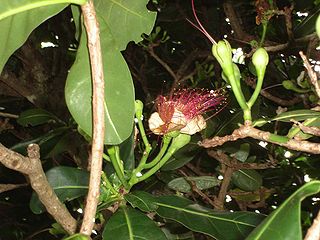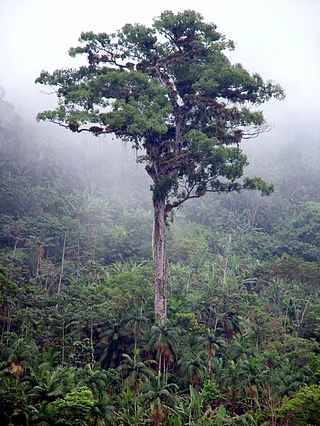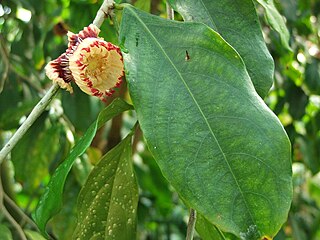
The Brazil nut is a South American tree in the family Lecythidaceae, and it is also the name of the tree's commercially harvested edible seeds. It is one of the largest and longest-lived trees in the Amazon rainforest. The fruit and its nutshell – containing the edible Brazil nut – are relatively large and weigh as much as 2 kg (4.4 lb) in total. As food, Brazil nuts are notable for diverse content of micronutrients, especially a high amount of selenium. The wood of the Brazil nut tree is prized for its quality in carpentry, flooring, and heavy construction.

The Lecythidaceae comprise a family of about 20 genera and 250–300 species of woody plants native to tropical South America, Africa, Asia and Australia.

Couroupita is a genus of flowering plants in the family Lecythidaceae first described as a genus in 1775. It is native to tropical South America and Central America.
- Couroupita guianensis - Cannonball tree -Guyana, Colombia, Ecuador east to Amapá and south to Bolivia; naturalized in the West Indies as well as in Bangladesh, Sri Lanka and Andaman & Nicobar
- Couroupita nicaraguarensis – Bala de cañón, coco de mono, paraíso, zapote de mico, or zapote de mono -Nicaragua, Costa Rica, Honduras, Panama
- Couroupita subsessilis - northern Brazil, northern Peru

Grias is a genus of flowering plants in the family Lecythidaceae, described by Linnaeus in 1759. It is native to northwestern South America, Central America, and Jamaica.

Couratari is a genus of trees in the family Lecythidaceae, first described as a genus in 1775. They are native to tropical South America and Central America.

Cariniana is a genus of trees in the family Lecythidaceae, first described as a genus in 1842. The entire genus is native to South America. Many are of importance for timber production. Species of this genus may be known commonly as jequitibá.

Cariniana pyriformis is a species of woody plant in the family Lecythidaceae. It is found in Brazil, Colombia, Costa Rica, and Venezuela. It is threatened by habitat loss.

Couratari guianensis, the fine-leaf wadara, cachimbo caspi, cachimbo, capa de tabaco, coco cabuyo, or tauari, is a species of woody plant in the family Lecythidaceae. It is found in Brazil, Colombia, Costa Rica, French Guiana, Guyana, Panama, Peru, Suriname, and Venezuela. It is threatened by habitat loss.
Eschweilera punctata is a species of woody plant in the family Lecythidaceae. It is found in Brazil and Colombia. It is threatened by habitat loss.
Grias colombiana is a species of woody plant in the family Lecythidaceae. It is found only in Colombia.
Grias haughtii is a species of woody plant in the Monkeypot family Lecythidaceae. It is found only in Colombia in non-flooded lowland forests. Its most remarkable feature is its leaves, which can be up to 5.5 feet in length by 16.5 inches in width. It also produces exceptionally large seeds, up to 2.7 inches (69 mm) in length by one inch (25 mm) in diameter.
Grias multinervia is a species of rainforest tree in the Monkeypot Family Lecythidaceae. It is found in Colombia and Ecuador. It is noteworthy for two things: Its very large seeds are up to three inches long by up to 1.17 inches wide. It also has very large leaves, up to 4' 9" long by up to 14 inches wide.
Gustavia petiolata is a species of woody plant in the family Lecythidaceae. It is found only in Colombia.
Gustavia pubescens is a species of woody plant in the family Lecythidaceae. It is found in Colombia and Ecuador.

Lecythis is a genus of woody plant in the Lecythidaceae family first described as a genus in 1758. It is native to Central America and South America. Several species produce edible seeds and referred to by a variety of common names including paradise nut, monkey pot, cream nut, and sapucaia nut.

Napoleonaea is a genus of woody plant in the family Lecythidaceae first described as a genus in 1804, the same year its namesake crowned himself Emperor of the French. The genus is native to Africa.

Gustavia is a genus of flowering plants in the family Lecythidaceae described by Linnaeus in 1775. It is native to tropical Central America and South America. Many of the species are threatened; some are critically endangered Gustavia superba, though, is actually abundant in re-growing secondary forests. It grows in northern South America, from Panama south through the Andes as far as Ecuador, and along the Caribbean coast and in the Amazon basin. Gustavia flowers have numerous stamens, in some species as many as 1,200 in a single flower.
Allantoma is a genus of woody plant in the family Lecythidaceae first described as a genus in 1874. It is native to northwestern South America (Colombia, Venezuela, Peru, northern Brazil.
- Allantoma decandra S.A.Mori, Ya Y.Huang & Prance - Peru, Brazil
- Allantoma integrifolia S.A.Mori - Amazonas State in Brazil
- Allantoma kuhlmannii S.A.Mori - Rondônia State in Brazil
- Allantoma lineata Miers - Amazonas State in Venezuela; Amazonas and Pará States in Brazil
- Allantoma pachyantha S.A.Mori, Ya Y.Huang & Prance - Amazonas State in Brazil
- Allantoma pauciramosa S.A.Mori, Ya Y.Huang & Prance - Amazonas State in Brazil
- Allantoma plurifloraS.A.Mori, Ya Y.Huang & Prance - Colombia
- Allantoma uaupensis S.A.Mori, Ya Y.Huang & Prance - Amazonas State in Brazil
Petersianthus is a genus of woody plant in the Lecythidaceae family first described as a genus in 1865 under the name Petersia. This turned out to be an illegitimate homonym, meaning that it had already been used by someone else to refer to a very different plant. So the name of these species in the Lecythidaceae was changed to Petersianthus. It is native to the Philippines and to parts of Africa. The following two species belong to this genus, with the basionyms of both taxa belonging to what is known today as the family Combretaceae.
- Petersianthus macrocarpus(P.Beauv.) Liben - Guinea, Ivory Coast, Cameroon, Congo Republic, Democratic Republic of the Congo, Cabinda, Gabon, Angola
- Petersianthus quadrialatus(Merr.) Merr. - Philippines

Scott Alan Mori was a Swiss and American botanist and plant collector. He specialized in the systematics and ecology of neotropical Lecythidaceae and Amazonian and Guianian floristics.











